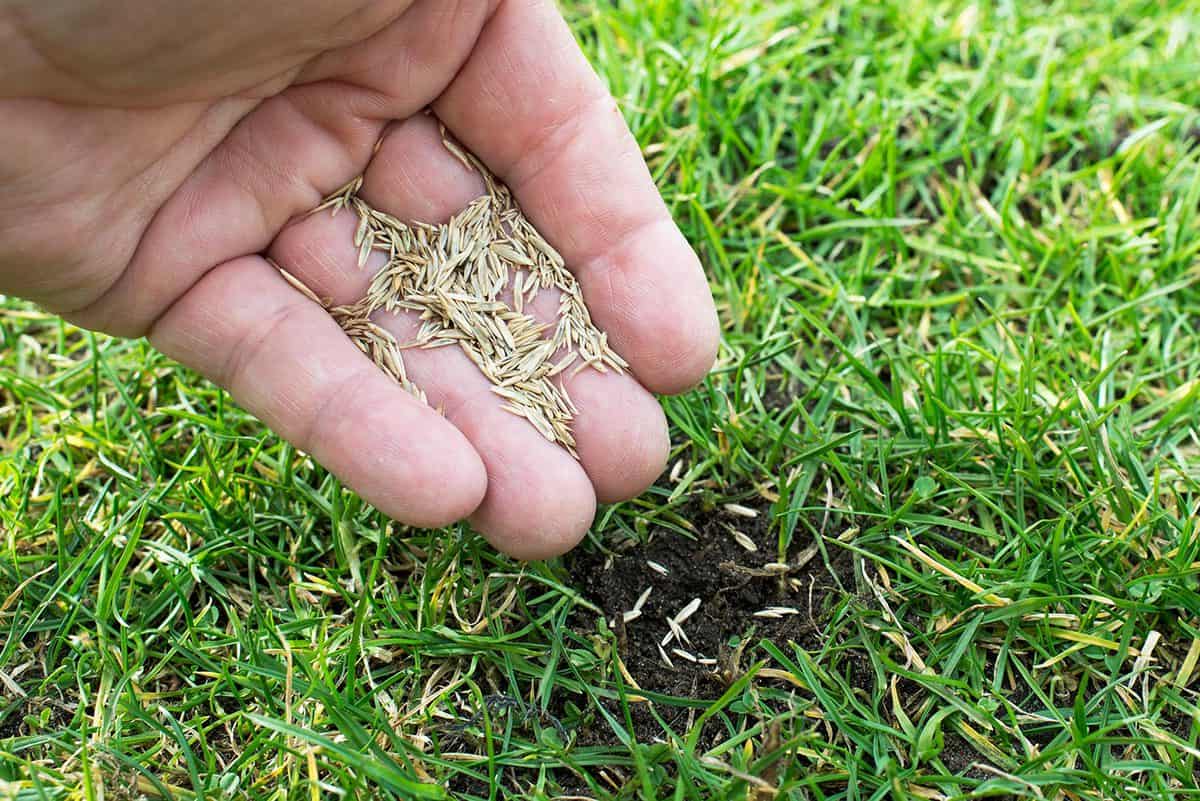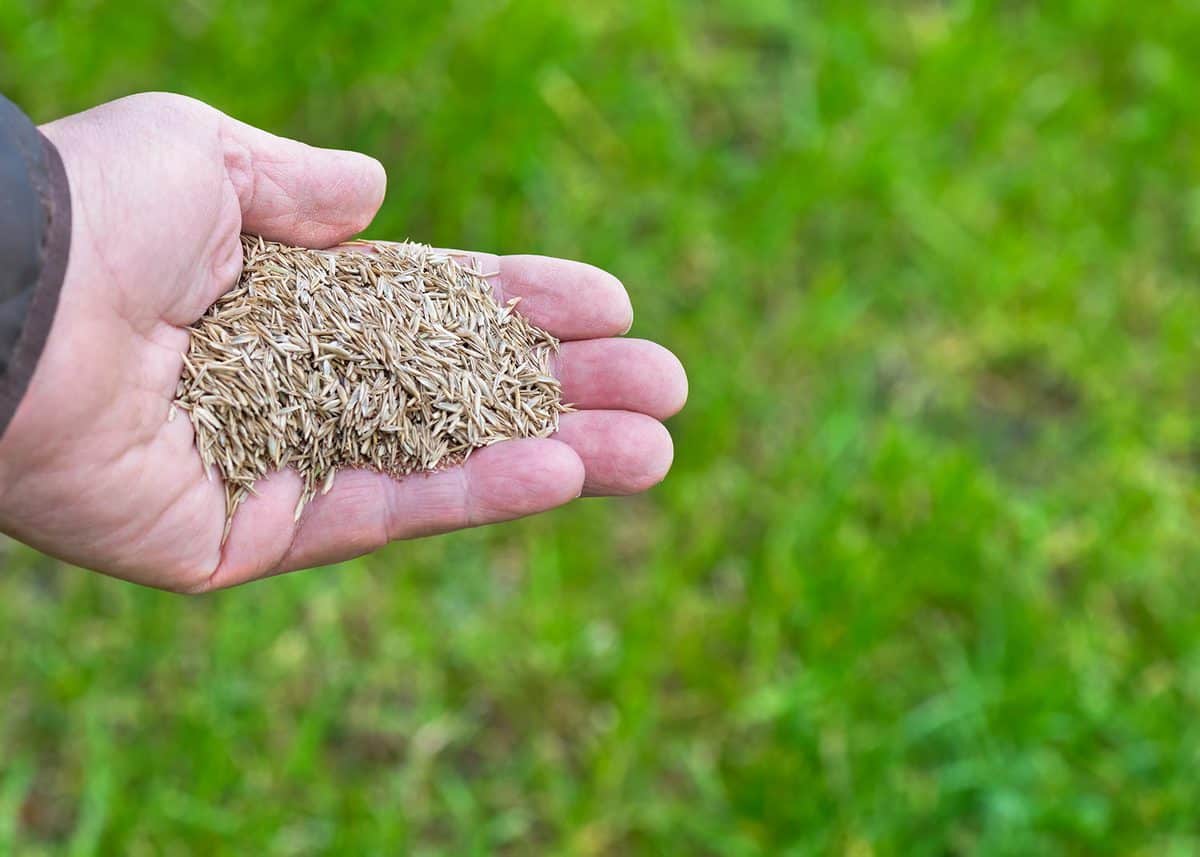Deciding how to keep your lawn looking lush and healthy can sometimes be challenging. Is it time to over-seed your grass, but you aren't sure whether to use compost or topsoil? Which is better? Luckily, we've done extensive digging into this topic and have the answers here for you. Let's discuss this below.
When it's time to over-seed your lawn, make sure to use compost rather than topsoil. Although topsoil may seem like a good choice, it won't provide your grass with nearly as many nutrients as compost will.
Generally, compost does a nice job of breaking down into the soil, increasing its overall health: and giving your lawn the chance to prosper.
As we begin, we will cover all things overseeding and discuss whether compost is truly better than topsoil. Whether your lawn looks like it needs some TLC or you want to keep it as healthy as possible, we're here to help. With that said, let's dive into this topic!
![Spreading grass seed in spring by hand for the perfect lawn, Compost Or Topsoil For Overseeding? [Which Is Best?]](https://gardentabs.com/wp-content/uploads/2022/05/Compost-Or-Topsoil-For-Overseeding-Which-Is-Best.png)
Should I Use Compost For Overseeding?
Yes, it is generally a good idea to use compost for overseeding a lawn. As we covered, the nutrients in compost will break down directly into the soil. That can help aid new grass growth, ultimately giving your grass the best chance to flourish.
Compost provides an optimal environment for seeds to grow, unlike topsoil, hence why we recommend it. Even though you can technically use topsoil while overseeding, you aren't going to have as good of results.

Furthermore, topsoil doesn't break down over time. That means your grass will have piles of soil unevenly placed around it, which isn't attractive.
Compost, however, will break down into the ground and won't leave any traces behind. So from an aesthetic and practical standpoint, it's the best option for overseeding.
Your compost doesn't need to be super strong, meaning you can use natural matter and maybe a few scraps from around your yard.
What Is The Best Compost To Use For Overseeding?
In general, you want to use nitrogen-rich compost with a small particle size for overseeding. You can use a "screened" compost or one that has a particle size of 3/8-inch or smaller.
Finding a smaller particle mix is crucial because it won't smother your grass. If you place super heavy compost and organic matter over your lawn, you could be doing more harm than good.
Considering that overseeding is the process of sprinkling new grass seeds over an existing lawn, you want to ensure they have room to breathe and grow.
If not, you may not see your new seedlings flourish, and even your current grass may start to grow unevenly. So when you're shopping for compost, find the smallest option available.
For those wanting to use compost from their bin, we recommend breaking it into fine pieces to prevent suffocating.
Blue Ribbon Organics Premium Compost
This organic, premium-grade compost has fine particles, promotes aeration and water retention, is odorless, works well for grass, weighs roughly 35 pounds, and has great reviews from customers.
Follow this link to view it on Amazon.
How Does Overseeding Work?
For anyone still unsure about how to over-seed their lawn, this is pretty simple. Overseeding is when you sprinkle seeds over an existing turf without tearing up the ground beneath it.
Unlike other more aggressive methods, overseeding is great for those not wanting to deal with plugs of soil everywhere or uneven patches of grass.
Doing this is an easy way to fill in bald patches, improve the thickness of your grass, and even enhance the color of your lawn. As we know, grass can be temperamental, so regular maintenance is essential.
As we covered, what you decide to use for overseeding makes a big difference. For example, if you sprinkle your grass seedlings and cover them with compost, there's a higher chance of success.
If you choose topsoil, you may be left with a dirt-covered, uneven lawn. Again, that isn't always the case, but it happens more than we would like.
How Often Should You Overseed A Lawn?

You want to over-seed a lawn about once every year. Many experts recommend annual overseeding because it promotes grass health, color, and thickness.
As we mentioned above, overseeding can improve the overall look of your grass. For example, sprinkling new seeds may do the trick if you have a lawn with bald spots or discoloration.
Like aerating, you don't want to do this too often, so every 12 months is fine. Although it may take a bit to see the results of your new seeds, it's important to give them enough time to grow.
According to Martha Stewart, using hardier grass varieties during overseeding can transform your garden into a lush, drought-tolerant place. With current climate change taking effect, this is perfect for those in the West, where drought is always on the horizon.
A few drought-tolerant types of grass we recommend include:
- Bermuda Grass
- St. Augustine Grass
- Buffalo Grass
- Centipede Grass
- Zoysia Grass
- Bahiagrass
- Tall Fescue
On top of these options, you can also try switching to an entirely faux turf, but that is a different conversation.
With the ever-changing conditions worldwide, it can be difficult to tell what exactly is the best option for your landscape, so everyone is different.
Can You Overseed Grass Too Much?

Yes, it is possible to over-seed grass too much. As we mentioned, you don't need to over-seed a lawn more than every 12 months. Although this can seem beneficial, sprinkling too many seedlings over your existing property can create unwanted competition.
Considering that the more living things in a given space, the fewer overall nutrients there are, so this can lead to bald spots, discoloration, and even total grass death.
Additionally, you might notice the new seeds you planted won't grow if you recently did this. That means you just wasted seeds and may have put your current lawn at risk.
The amount of compost you spread over grass can also cause issues. As we said, the compost/organic matter you decide to use during overseeding needs to be fine.
Even then, if you're overseeding and using compost multiple times per year, this can result in a suffocated yard. So if it's been less than 12 months, we don't recommend overseeding.
What Happens If You Don't Overseed A Lawn?
If you decide not to over-seed your lawn, there won't technically be any negative effects. In general, doing this isn't required, so you don't have to sprinkle new seedlings over your property if you don't want to.
With that said, overseeding can benefit a patchy lawn. Regularly adding new, drought-tolerant/hardy varieties to existing grass can build a stronger, healthier turf.
On top of that, planting fresh seeds in your current lawn can help strengthen its ability to handle seasonal temperature fluctuations.
For example, if you over-seed with winter-friendly grass, you may not see as much overall death in the upcoming cold season.
Adversely, many climate experts recommend against overseeding entirely. According to the city of Mesa, Arizona, you can save over 8,000 gallons of water for every 1,000 square feet of grass each season you don't over-seed.
That is a significant number, and with the current water crisis, you may want to skip this year's overseeding. Furthermore, if you're in the desert, you may want to skip planting grass altogether.
Can You Use Household Items For Overseeding Compost?
If you have a compost bin or pile started for your home, you might be able to use it for overseeding. Typically, the compost you use to over-seed needs to be ultra-fine, so everyday scraps won't work.
However, if you grind your compost into tiny particles, we don't see a problem. Some experts recommend using a mulching mower to spread your compost, so that's another idea to try.
You can also stick to a pre-mixed and ground compost product, so if you don't want to do much work, that's what we recommend.
Regardless, make sure your compost is rich in nitrogen and has tiny particles.
Is Maintaining Grass Difficult?

Although having grass can make your property look better, it comes with plenty of upkeep. In general, grass is not super easy to manage and can take a turn for the worst in the blink of an eye.
However, with routine maintenance, like proper watering, mowing, fertilization, and overseeding, we're sure you can keep your lawn looking beautiful.
With that said, it can be costly to keep a lawn green and lush. For example, your watering schedule maybe 1-2 times per week, which means a bigger monthly bill.
You may choose to install an irrigation system, which can cost upwards of $2,000, so this isn't for the faint of heart. Again, if you live somewhere with moderate weather and regular rainfall, grass is a great idea.
If you live in the desert and don't want to waste water, consider a fake turf or a different landscape idea.
To Wrap It Up
Whether you currently have grass or want to grow it, knowing the basics of upkeep is essential. You wish to over-seed your lawn using finely ground compost from what we found.
Doing this will ensure your grass seeds have room to breathe and grow while providing plenty of nutrients. On the other hand, you can use topsoil for overseeding, although it isn't always as effective and can make a mess.
Regardless, try to over-seed with drought-tolerant grass varieties and wait 12 months between each application.
Made it to the end? Check out these super helpful lawn posts below!
When Does Bermuda Grass Grow? [And When Does It Go Dormant]


If you are asking yourself, ‘where do I find the best lawn fertilization company near me?’ then look no more. Green Scene Landscape can do the handle Lawn weed control, and other lawn care services with ease, and as per your convenience.